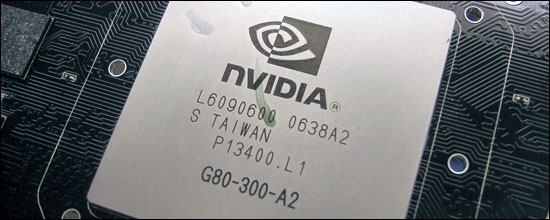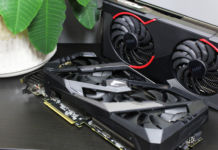NVIDIA has finally launched its first graphics card based on the G80 architecture and the flagship GeForce 8800 GTX is, put mildly, a beast. We’ve taken a closer look at how the card performs in the hands of some real enthusiasts.
The time has come for NVIDIA to launch its latest weapon on the graphics card market and after the turbulence surrounding AMD’s acquisition of arch rival ATI the focus has slipped a little from the products to the manufacturers. Now it’s time to change all that and the upcoming future we can promise you that there will be loads of articles and information about NVIDIA’s new graphics card series; GeForce 8800.
NVIDIA’s new architecture has been one of the best kept secrets in a very long time and even if there are tons of rumors most of them have been wrong. NVIDIA has done everything to keep G80 a secret, it has done a great job too and we are not surprised why. The graphics cards have become more and more advanced over the years and the fact that both transistors and power consumption have gone way past those we’ve seen for processors is a proof of that. But this generation, by that we mean NVIDIA G80 and ATI’s coming R600, will be something really extraordinary. Neither NVIDIA nor ATI are holding anything back but are going for the most brutal performance with new architectures with hundreds of millions transistors. We will publish a more thorough review of NVIDIA’s flagship later on, but as the time has been quite narrow and a whole new architecture like G80 requires a thorough dissection while at the same time we want to spend more time with the card before we hand out our final judgment.
But in the true spirit of NordicHardware we done precisely what NVIDIA has, we throw away all boundaries and push NVIDIA’s enthusiast card to the extreme. That the flagship GeForce 8800 GTX is a graphics card for computer enthusiasts and overclockers is a given, so we felt it was the right thing to out the card in the hands of one of the world’s best overclockers Marcus ”Kinc” Hultin. Today we offer you a short overclocking preview of GeForce 8800 GTX, but we will have a full review available for you soon and several overclocking articles with focus on, amongst others, GeForce 8800 GTX.
In this preview we will be focusing on overclocking GeForce 8800 GTX, but before we begin we will take a quick peek at the G80 architecture. A more extensive analysis of G80 will be in our full review, but this way it will be easier to understand NVIDIA’s new and a bit different architecture.
nVidia-reference frequencies, may vary between manufacturers.
** nVidia-reference, depends on the frequencies.
NVIDIA and ATI have both released refined graphics cards based on the current generation of GPUs. NVIDIA launched its 7900GTX earlier this year and not too long ago ATI launched X1950XTX. Both cards introduced somewhat new names, but we haven’t seen any significant improvement since G70 and R520/R580 was launched. NVIDIA is the first to launch a card of the new generation with its GPU G80, with DirectX 10 support and a rigorous gain in performance.
As we mentioned earlier we will dig deeper into G80 and its new architecture in our coming review. The most important detail from a performance point of view is that G80 has 128 shaders (streaming processors) which each can handle pixel, vertex, geo or physics instructions. To be able to feed all shaders with the data they need, G80 comes with an expanded memory interface at 384bit, which is the widest we’ve ever seen with a graphics card for gaming. 768MB GDDR3 clocked at 900MHz through chips manufactured by Samsung ranked at 1.0ns, which means that 1100MHz shouldn’t be a problem when we start to overclock.
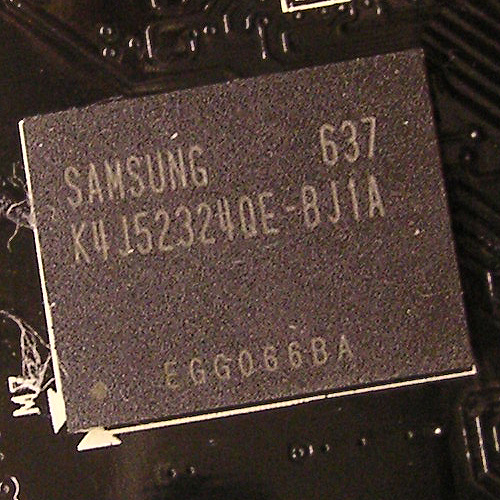
We will continue on the next page with a presentation of the test system and quick description of the synthetic tests to demonstrate the performance at default clocks.
As you can see on the picture below we’ve modified the stock cooler a little and increase the airflow through the cooler profile by using a channel fan at 1000W using air coming from the outside(10°C).

| |
Test system | |
| Hardware | |
| Motherboard | Intel Bad Axe 2 |
| Processor | Intel Core 2 Extreme X6800 |
| Memory | Corsair PC6400C3 2x1024MB |
| Harddrive | WD Raptor 36GB 10 000 RPM |
| Monitor | Dell UltraSharp 2405FPW |
| Graphics cards | XFX GeForce 8800GTX 768MB ATI Radeon X1950XTX 512MB |
| Power supply | Cooltek 600W |
| Software | |
| Operating system | Windows XP (SP2) |
| Drivers | Catalyst 6.10 ForceWare 96.89 |
| Monitoring program | – |
| Benchmark program |
3DMark 01SE |
As a reference we’ve performed two quick tests 3DMark 05 and 06 using X8800GTX and X1950XTX running at stock frequencies.
ATI and the X1900 series are traditionally strong in 3DMark 05, but we can see that X1950XTX gets a real nice whopping by 8800GTX.
In 3DMark 06, which isn’t limited by the CPU in the same way as 3DMark 05 we see how good 8800GTX really is. You could say that GeForce 8800GTX is just as good as or better than any G71/R580 multi-GPU solution with these tests.
On the next page we start with what you all have been waiting for.
The stock cooler offers good potential for overclocking, 650/2200 was not problem with any of the 3DMark tests. Air cooling in all respect, but why not take it one step further? The cooler is practically made for mounting a channel fan. It’s not the first time we use this method to improve the cooling, but the fact is that 8800GTX is the card which has turned out to work best with this method.
We start off with the freshest one, 3DMark 06. As you perhaps know 3DMark 06 is the first 3DMark which includes a CPU score in the final result. A QX6700 had easily boosted the score way over.
3DMark 06 – 13,234 points 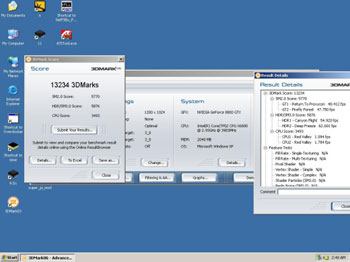 |
||
| Specifications | ||
| Intel Core 2 X6800 | 3980MHz (9×442) | |
| Corsair 6400C3 | 442MHz 3-3-3-5 | |
| GeForce 8800GTX | 692/2220MHz | |
We continue with 3DMark 05, which is still a personal favorite. As far as we know the following results are single-card world records, if not is a guaranteed world record with air cooling.
3DMark 05 – 22,196 points 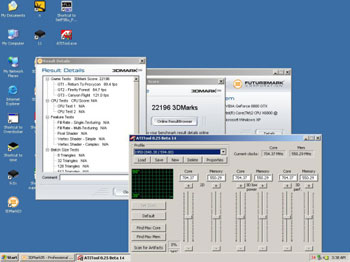 |
||
| Specifications | ||
| Intel Core 2 X6800 | 4050MHz (9×450) | |
| Corsair 6400C3 | 450MHz 3-3-2-4 | |
| GeForce 8800GTX | 704/2200MHz | |
3DMark03 is a test where NVIDIA is completely superior to ATI and GeForce 8800GTX is no exception.
3DMark 03 – 43,795 points 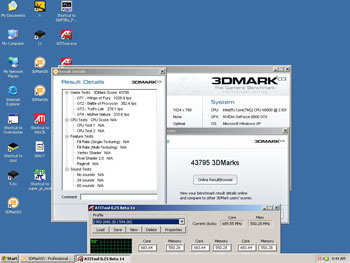 |
||
| Specifications | ||
| Intel Core 2 X6800 | 3980MHz (9×442) | |
| Corsair 6400C3 | 442MHz 3-3-3-5 | |
| GeForce 8800GTX | 683/2200MHz | |
The good ol’ 3DMark01SE has lost its role as a synthetic test, but is still 3DMark numero uno to many. The results with the immortal classic have been increasing significantly after that Intel launched its Core 2 Duo processor. Do notice that the nature score is really the only one which really shows what t 8800GTX can do.
3DMark 2001SE – 72,514 points 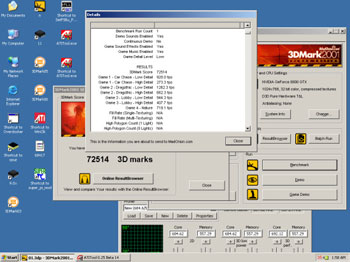 |
||
| Specifications | ||
| Intel Core 2 X6800 | 3980MHz (9×442) | |
| Corsair 6400C3 | 442MHz 3-3-3-5 | |
| GeForce 8800GTX | 692/2228MHz | |
Overall impressive performance and the overclocking potential of GeForce 8800 GTX is rather surprising considering it’s a fresh high-end graphics which was just launched, something which otherwise has a tendency to be pushed to the limit by the manufacturer self. We will try to summarize our experiences and impressions so far and what kind of material you will get from us here at NH about G80 the upcoming future.
Already during the short period of time we’ve had with NVIDIA’s new flagship it’s pretty clear that the G80 architecture is something above the rest. Alas, we haven’t had the time to dig any deeper into this in this article, but we will do so in our full review of the card. Already we can make some conclusions from our GeForce 8800 GTX and that is that the bad rumors about unified shaders and poor DirectX 9.0 performance are far from true. Even if Windows Vista and DX10 should unlock new possibilities for G80 and coming DX10-capable architectures there is a lot to gain today already. The performance we’ve seen is nothing but impressive, but it comes at a price.
GeForce 8800 GTX has close to 700 million transistors and these transistors consume a lot of power and at the same generate heat. The power consumption is not as bad as some early reports indicated and much of this is because NVIDIA has settled for a relatively low clock frequency. They realized that there was enough performance anyway, because the G80 core can be pushed far beyond 575MHz. The cooler is very efficient and quiet, but also gets really hot, so despite its massive size it has a tough job to handle.
Other than that we can’t make any bigger conclusions until we publish our full review where we will present a lot more information about the architecture, its performance and other interesting bits. Except from our review we will of course continue with even more extreme overclocking projects where G80 from now on is a given participant. Amongst others, NordicHardware will be at DreamHack Winter 2006 with both Intel’s Core 2 Extreme XQ6700 processor and NVIDIA GeForce 8800 GTX SLI. The goal is of course to set new world records live at DreamHack and the ones doing it are of course Kinc and crotale, as usual. At least one thing is for certain, many new records will be set now that GeForce 8800 GTX has arrived.
GeForce 8800 GTX and its sibling, GeForce 8800 GTS will be available in stores today. The resistor value problems we’ve reported about earlier hasn’t affected NVIDIA’s hard launch, which means that the card will come as planned. The price of the flagship is not for the fainthearted though; $600-700. GeForce 8800 GTS, which we still haven’t had the pleasure of meeting costs a little less; about $430-450. But as always, if you want to stay at the top fighting the best you have to pay up and right now there is no greater weapon that the GeForce 8800 GTX.





